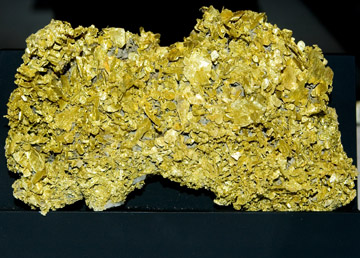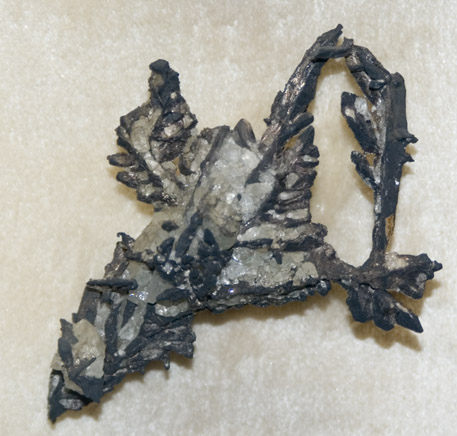GOLD AND PRECIOUS METALS
Gold
PHYSICAL PROPERTIES PROPERTIES OF GOLD
Crystal system: Cubic
Chemical Formula/composition: gold is a native
element, symbol is Au (from the Greek word for gold)
Crystal habit: Crystals are rare, found
as leaf, plate, nuggets, and electrum
Hardness: 2-2.5 on Mohs scale in its pure
state (softer than a fingernail).
Specific gravity: 19.33
Luster: Metallic
Toughness: not tough, but extremely malleable
and ductile.
Cleavage: None
Optics: opaque
Color: shades
of yellow or amalgamated with other substance may even be a black color
Other: Melting point of 1945 degrees Fahrenheit
(1063 degrees C)
Localities:
Common simulants: Gold plate, plastics, Pinchbeck
(a type of brass)
Synthetics: None, though alchemist tried for
centuries. The elusive philosopher's stone was supposed to turn lead
into gold.
Gold is one of the most desirable and precious metals. What makes
gold valuable, along with its scarcity, are its physical properties that
have made it the most popular metal for use in jewelry. Platinum and silver
are also very desirable for jewelry and are discussed briefly.

Gold from a gold vein.
Gold has been known since ancient times. Its color pleases almost
everyone. Its softness and only moderate melting point allowed it
to be worked even in cultures that were relatively primitive (pre-industrialized).
Gold is more malleable than any other metal and can be hammered or rolled
into foil so thin that it is nearly transparent and thinner than writing
paper Its great ductility allows it to be drawn into wire so fine it can
barely be seen ( a gram of gold can be made into a wire that stretches
approximately 3 km [2 miles]).
Gold also has the ability to withstand tarnishing (oxidizing) and corrosion,
it stays bright and the color never fades with time. For instance,
gold jewelry recovered from ancient Egyptian tombs is as wearable today
as it was 4000 years ago.
Gold is scarce and therefore expensive. Only 152,000 metric tons of gold
have been mined the world over since the beginning of time. These
physical properties make it extremely desirable for making jewelry.
Besides jewelry, it has industrial applications in electronics and so there
is high demand.
Though soft in its pure state, fortunately, gold becomes harder when
alloyed with various base metals. You would not want to have a pure
gold ring because it could easily get bent and deform on your finger and
be difficult to remove. Luckily it is able to bond with other base
(non-valuable) metals. This property gives rise to the many different colors
available in modern gold alloys (described below). Gold is found in nature
with other metals in alloys, one example is electrum which contains
more than 20% silver. When gold is mixed with other metals by man it said
to have been alloyed (chemically combined). The less valuable
metal is referred to as base metal. The gold usually become
harder and the melting temperature of the resulting alloy is changed. 18K
(75% gold and 25% base metal [50% silver and 50% copper mixed with the
gold]). Yellow gold has a melting point of 1675 degrees Fahrenheit
and 14K (58%) yellow gold has a melting point of about 1550 degrees Fahrenheit.
Gold has a specific gravity of 19.33, silver has a specific gravity
of 10.7, and Platinum has an SG of 21.4. Platinum has a melting point of
1945oF. , (1063 oC).
TYPES OF GOLD MADE BY AMAGALMATION
Yellow gold--50% silver and 50% copper
White gold--Nickel, zinc, copper, tin and manganese (the nickel and
other impurities can cause allergies).
Pink (rose) gold--90% copper and 10% silver
Green gold--High proportion of silver or cadmium
Blue gold--Some iron
Grey gold--15-20% iron
Other terms for gold that you may see:
RUSSIAN GOLD FINISH--matte, has an antique-look .
VERMEIL--Vermeil is gold-plated silver. Occasionally, gold-plated bronze
is referred to as vermeil. Production of vermeil was banned in the early
1800s; however, when it was discovered that the mercury used in the process
caused the craftsmen to go blind. Mercury is often used to amagalmate
gold and silver, and that is one reason why silver fillings (amalgum) are
out of fashion.
PINCHBECK--Pinchbeck (aka "false gold") is an alloy of copper and zinc,
which makes it a type of brass, with no gold. It was invented by
the British watchmaker Christopher Pinchbeck (1672-1732) and consists of
83% copper and 17% zinc. It looks remarkably like gold (so get a
gold tester before you buy a watch or chain on the street or you may have
a green ring around you neck!). The term PINCHBECK also means counterfeit,
cheap, or tawdry.
GOLD PURITY
The purity of gold is defined by the term
karat (K),
which
is 1/24 part of pure gold by weight. Pure gold is equivalent to
24K.
Gold purity may also be described by its fineness, the amount of
pure gold in parts per 1000. For example, a gold ring containing 750 fine
gold has 750 parts (75%) gold and 250 parts (25%) of other base metals.
What is the karat weight of 750 gold?
The United States Federal Trade Commission rules require that all jewelry
items sold as gold shall be described by "a correct designation of the
karat fineness of the alloy." No jewelry item less than 10K may be sold
in the United States as gold jewelry.
Karat Value Definitions:
-
Karat System: A system of measurement based on 24 karats being "fine"
or "pure" gold. 1 karat equals 1/24th fine gold by weight. This is the
system used in the United States.
-
Plumb Gold: Karat weights are usually determined with a small, fractional
variance allowed. Karat gold which has no variance and is exactly the precise
fractional karat weight is called "plumb" gold.
-
European System: A system of measurement based on a fraction of
1,000; or the number of grams of gold in 1 kilogram of alloy.
The following table lists the relationship between different international
gold markings.
| Karat Gold |
Parts Gold |
Percentage Gold |
Normal European Stamping |
| 9 K |
9 in 24 |
37.50% |
375 |
| 10 K |
10 in 24 |
41.67% |
416 |
| 12 K |
12 in 24 |
50% |
500 |
| 14 K |
14 in 24 |
58.33% |
583 or 585 |
| Fill in __ K? |
_ ?in 24 |
75% |
750 (see question above) |
| 22 K |
22 in 24 |
91.67% |
917 |
| 24 K |
24 in 24 |
99.99% |
999 or .99999 |
WEIGHING PRECIOUS METALS
The weight of a piece of gold jewelry is a factor that helps to determine
its value. It is important because it is an indication of the amount of
fine gold in an item of jewelry. Grams (g) and pennyweights (dwt) are the
units of weight most commonly used in weighing gold. Gold and silver are
almost always weighed in the troy system of weights,where one pound troy
equals twelve troy ounces and twenty pennyweights equal one troy ounce.
The avoirdupois weight system, where one pound equals 16 ounces, is used
in the United States for almost everything except precious metals. The
following table summarizes useful weight conversions.
WEIGHT CONVERSIONS
| 1 gram (g) |
= 0.643 dwt = 0.0032 oz t
= 0.035 oz av |
| 1 pennyweight (dwt) |
= 1.555 g = 0.05 oz t = 0.055
oz av |
| 1 troy ounce (oz t) |
= 31.103 g = 20 dwt = 1.097
oz av |
| 1 ounce avoirdupois (oz
av) |
= 28.3495 g = 18.229 dwt
= 0.911 oz t |
Platinum
Crystal system: Cubic
Chemical Formula/composition: Platinum is
a native element, symbol is Pt
Crystal habit: Crystals are rare, nuggets
Hardness: 3.5 on Mohs' scale in its pure state
(harder than calcite).
Specific gravity: 21.45
Luster: Metallic
Toughness: more brittle than gold, can not
be hammered into jewelry, not as ductile.
Cleavage: None
Optics: opaque
Color: shades
of gray
Other: Melting point of 3222°F (1772°C)
(very high melting point)
Localities: Rustenberg, South Africa; Former
Soviet Union, South America
Common simulants: White gold (a mixture of
gold and palladium), Palladium (considerably cheaper)
Platinum is typically sold using the finess scale described above as
"Normal European Stamping." That is parts out of 1000. Platinum
is preferred to white gold because it is both rarer and harder in its pure
form. Platinum sells for over $1000 per ounce (July 4, 2008 price
was around $2,001 per ounce; gold at that time was $933.45).

Platinum nuggests the largest is approximately 1.5 inches across.
Platinum is a member of the platinum group elements that include five
other metallic elements, palladium, ruthenium, rhodium, osmium, and iridium.
These elements are of value in scientific instruments and palladium has
been used in jewelry.
The early history of platinum use is rather sparse. Platinum's
very high melting point made it extremely difficult to use in preindustrialized
cultures. Apparently some South American peoples used platinum before
the Spaniards arrived but were unable to melt it. Platina, from which
the word platinum is derived, is a diminutive which means little silver
and the Spanish did not regard the metal as having any great worth.
Until the 1970s no standards were available world-wide for platinum
fineness. Today platinum is sold in 850, 900, 950, and 999 purities
and is alloyed with copper, iridium, palladium, rhodium, osmium, or titanium.
Besides its use in jewelry, platinum is also used in catalytic converters
in automobiles.
Silver
Crystal system: Cubic
Chemical Formula/composition: Silver is a
native element (however it also is found in minerals as a compound), symbol
is Ag
Crystal habit: Crystals are rare, often
occurs as wiry aggregates or dendritic masses
Hardness: 2.5 on Mohs' scale in its pure state
(harder than gold).
Specific gravity: 10.5
Luster: Metallic
Toughness: less ductile and malleable than
gold, but still has relatively high ductility and malleability
Cleavage: None
Optics: opaque
Color: shades
of gray tarnishing to black
Other: Melting point of 1763°F (961.5°C)
Localities: Mexico, Canada, Peru, and the
USA,
Common simulants: Pewter (85 and 99 % tin,
with the remainder consisting of 1-4 % copper); German silver ( 65% copper,
18% nickel, 17% zinc).
Silver is used in jewelry, silverware, coins, the reflective coating
of mirrors, and in the photographic processes of black and white film.
It is malleable and ductile (though not to the extent of gold). Silver
tarnishes, turning black on the surface layer. Tarnishing is usually
due to exposure to sulfuric fumes or chlorides.

Native silver forming dendritic crystals in quartz.
Silver is deposited from hot water in hydrothermal veins. It is often
found with other metals such as gold, copper, and lead. Unlike gold
it is easily dissolved by acids, oxidized, and is susceptible to the elements
(it can weather away). However, the tarnish on silver objects slows
their degradation and many ancient objects have been recovered from shipwrecks,
etc.
Silver is referred to as sterling silver if it is 92.5% pure silver
or higher. The other 7.5% is usually copper. Sterling is marked
on jewelry and other decorative items as either: sterling, ster, or 925
(finess out of 1000 parts). Britannia silver and Mexican silver both
have a higher fineness than sterling of at least 950 parts per thousand.
The price of silver is very low compared to that of gold or platinum.
Currently (July 4, 2008) silver is selling for about $18.00 per ounce (more
than 51 times less than gold).
Return to the syllabus main site
Return
to the Biological Sciences and Geology Website


